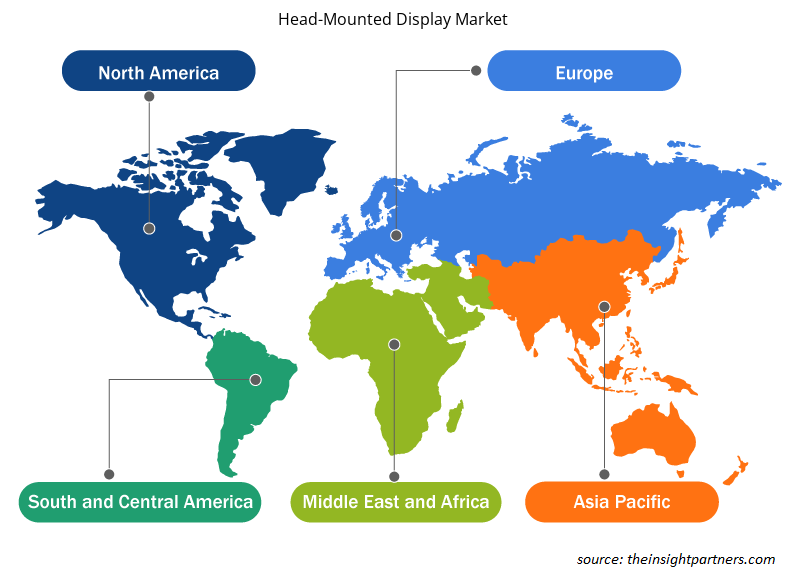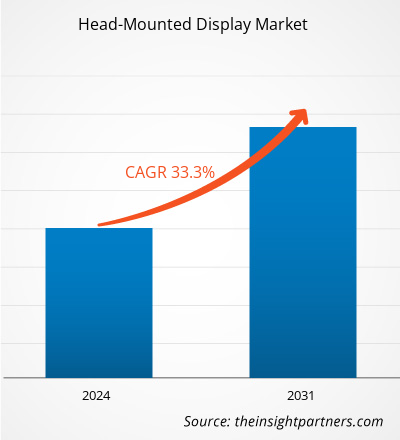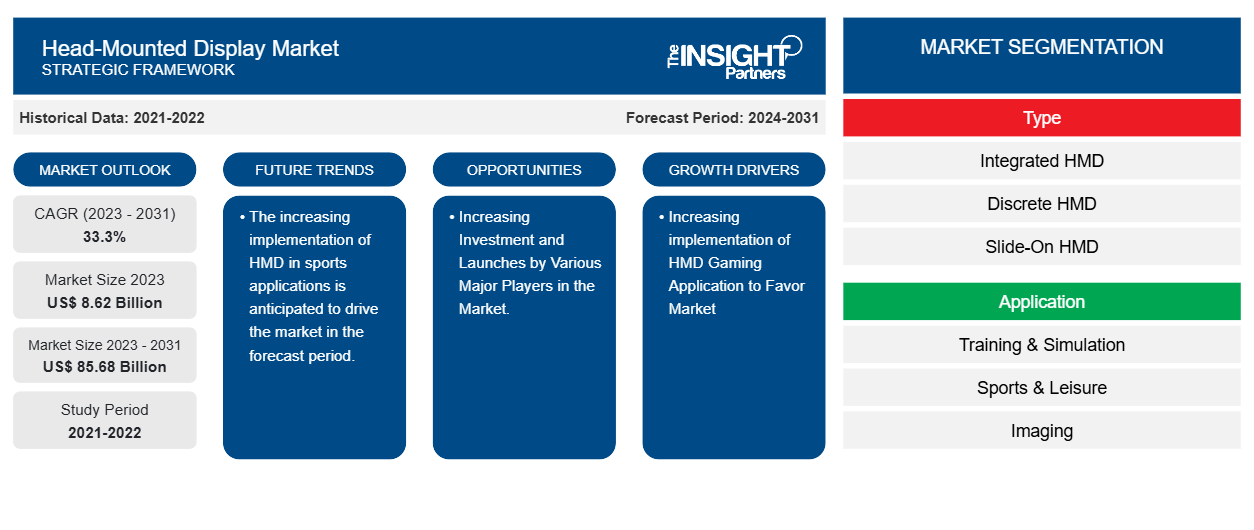Der Markt für Head-Mounted-Displays soll von 8,62 Milliarden US-Dollar im Jahr 2023 auf 85,68 Milliarden US-Dollar im Jahr 2031 anwachsen. Der Markt soll zwischen 2023 und 2031 eine durchschnittliche jährliche Wachstumsrate (CAGR) von 33,3 % verzeichnen. Die Implementierung von HMDs in Gaming-Anwendungen und die zunehmende Verbreitung von AR/VR-Headsets im gesamten Militärsektor dürften die wichtigsten Treiber und Trends des Marktes sein.
Marktanalyse für Head-Mounted Displays
Der Markt für Head-Mounted-Displays verzeichnet weltweit ein deutliches Wachstum. Dieses Wachstum ist auf Faktoren wie die Implementierung von HMDs in Gaming- Anwendungen und die zunehmende Verbreitung von AR/VR-Headsets im gesamten Militärsektor zurückzuführen. Darüber hinaus wird erwartet, dass die zunehmenden Investitionen wichtiger Akteure in die Entwicklung von HMDs und die Implementierung von HMDs in Sportanwendungen in den kommenden Jahren mehrere Chancen für den Markt bieten werden.
Marktübersicht für Head-Mounted-Displays
Ein Head-Mounted Display (HMD) ist eine Art Computeranzeigegerät oder Monitor, der, wie der Name schon sagt, auf dem Kopf getragen oder als Teil eines Helms eingebaut wird. Diese Art von Display ist für ein vollständiges Eintauchen des Benutzers in das Erlebnis gedacht, für das das Display gedacht ist, da es sicherstellt, dass sich das Display mit den Bewegungen des Benutzers bewegt.
Passen Sie diesen Bericht Ihren Anforderungen an
Sie erhalten kostenlos individuelle Anpassungen an jedem Bericht, einschließlich Teilen dieses Berichts oder einer Analyse auf Länderebene, eines Excel-Datenpakets sowie tolle Angebote und Rabatte für Start-ups und Universitäten.
-
Holen Sie sich die wichtigsten Markttrends aus diesem Bericht.Dieses KOSTENLOSE Beispiel umfasst eine Datenanalyse von Markttrends bis hin zu Schätzungen und Prognosen.
Treiber und Chancen auf dem Head-Mounted-Display-Markt
Zunehmende Implementierung der HMD-Gaming-Anwendung begünstigt den Markt
AR/VR/MR wird durch die Verwendung spezieller Geräte namens HMD erlebt. Die meisten HMDs basieren auf der stereoskopischen 3D-Anzeigetechnik. Dabei wird ein Tiefensignal namens Stereopsis genutzt, das nichts anderes ist als die Tiefe, die das menschliche Auge wahrnimmt, da jedes unserer beiden Augen eine Szene aus einer leicht unterschiedlichen Perspektive sieht. Gaming-Anwendungen, die HMDs nutzen, bieten ein hochgradig immersives Erlebnis, indem sie eine virtuelle Umgebung schaffen, die den Spieler umgibt. Dieses Maß an Immersion ist ein wichtiges Verkaufsargument und kann sowohl Gelegenheits- als auch Hardcore-Gamer anziehen. Darüber hinaus machen kontinuierliche Verbesserungen der HMD-Technologie, wie z. B. bessere Auflösung, breiteres Sichtfeld, reduzierte Latenz und verbessertes Tracking, das Gaming-Erlebnis realistischer und angenehmer und ermutigen mehr Benutzer, diese Geräte zu verwenden.
Zunehmende Investitionen und Markteinführungen durch verschiedene große Akteure.
Die steigende Zahl von Produkteinführungen durch die großen Marktteilnehmer dürfte dem Markt zahlreiche Chancen eröffnen. Neue Produkteinführungen bringen oft erweiterte Funktionen, verbesserte Technologie und bessere Leistung mit sich. Verschiedene Produkteinführungen, wie beispielsweise Sony und Siemens, kündigten an, dass sie bis Dezember 2024 Virtual-Reality -Headsets für den industriellen Metaverse-Fokus des letzteren auf den Markt bringen werden. Das Produkt ist derzeit in die Engineering-Design-Plattform NX von Siemens integriert und wird auf andere Produkte ausgeweitet. Daher wird erwartet, dass eine steigende Zahl von Investitionen und Markteinführungen durch verschiedene große Akteure das Marktwachstum vorantreiben wird.metaverse focus by December 2024. The product is currently integrated with Siemens’ engineering design platform NX and will be expanded to other products. Thus, a surging number of investments and launches by various major players is anticipated to drive market growth.
Head-Mounted Display-Marktbericht – Segmentierungsanalyse
Wichtige Segmente, die zur Ableitung der Marktanalyse für Head-Mounted-Displays beigetragen haben, sind Typ, Anwendung, Komponente, Technologie, Design und Verbindung.
- Basierend auf dem Typ ist der Markt für Head-Mounted-Displays in integrierte HMDs, diskrete HMDs und Slide-On-HMDs unterteilt. Das Segment der integrierten HMDs dürfte im Prognosezeitraum einen erheblichen Marktanteil halten.HMD, discrete HMD, and slide-on HMD. The integrated HMD segment is anticipated to hold a significant market share in the forecast period.
- Basierend auf der Anwendung ist der Markt für Head-Mounted-Displays in Training und Simulation, Sport und Freizeit, Bildgebung, Verteidigung und Sicherheit und andere unterteilt. Das Segment Radiation Hardening by Design (RHBD) wird im Prognosezeitraum voraussichtlich einen erheblichen Marktanteil halten.RHBD) segment is anticipated to hold a significant market share in the forecast period.
- Nach Komponenten ist der Markt segmentiert in Bildschirme, Controller, Sensoren, Kameras und Sonstiges. Es wird erwartet, dass das Segment Bildschirme im Prognosezeitraum einen erheblichen Marktanteil halten wird.
- Nach Technologie ist der Markt in Augmented Reality, Virtual Reality und Mixed Reality unterteilt. Es wird erwartet, dass das Segment der Bildschirme im Prognosezeitraum einen erheblichen Marktanteil halten wird.
- Der Markt ist konzeptgemäß in Head-Mounted-Displays und tragbare Brillen segmentiert. Das Segment der Displays dürfte im Prognosezeitraum einen erheblichen Marktanteil halten.
- Nach Verbindung ist der Markt in kabelgebundene, kabellose und hybride Verbindungen unterteilt. Es wird erwartet, dass das kabelgebundene Segment im Prognosezeitraum einen erheblichen Marktanteil halten wird.
Marktanteilsanalyse für Head-Mounted Displays nach Geografie
Der geografische Umfang des Marktberichts für Head-Mounted-Displays ist hauptsächlich in fünf Regionen unterteilt: Nordamerika, Asien-Pazifik, Europa, Naher Osten und Afrika sowie Süd- und Mittelamerika.
Nordamerika dominiert den Markt für Head-Mounted Displays. Die zunehmende Einführung von Technologien in verschiedenen Branchen in Nordamerika hat das Wachstum des Marktes für Head-Mounted Displays vorangetrieben. Faktoren wie die zunehmende Einführung digitaler Tools und hohe Technologieausgaben von Regierungsbehörden dürften das Wachstum des nordamerikanischen Marktes für Head-Mounted Displays vorantreiben. Darüber hinaus zwingt eine starke Betonung von Forschung und Entwicklung in den entwickelten Volkswirtschaften der USA und Kanadas die nordamerikanischen Akteure dazu, technologisch fortschrittliche Lösungen auf den Markt zu bringen. Darüber hinaus gibt es in den USA viele Akteure auf dem Markt für Head-Mounted Displays, die sich zunehmend auf die Entwicklung innovativer Lösungen konzentrieren. All diese Faktoren tragen zum Wachstum des Marktes für Head-Mounted Displays in der Region bei.
Regionale Einblicke in den Head-Mounted-Display-Markt
Die regionalen Trends und Faktoren, die den Markt für Head-Mounted Displays während des Prognosezeitraums beeinflussen, wurden von den Analysten von Insight Partners ausführlich erläutert. In diesem Abschnitt werden auch die Marktsegmente und die Geografie für Head-Mounted Displays in Nordamerika, Europa, im asiatisch-pazifischen Raum, im Nahen Osten und Afrika sowie in Süd- und Mittelamerika erörtert.

- Holen Sie sich die regionalspezifischen Daten für den Head-Mounted-Display-Markt
Umfang des Head-Mounted Display-Marktberichts
| Berichtsattribut | Details |
|---|---|
| Marktgröße im Jahr 2023 | 8,62 Milliarden US-Dollar |
| Marktgröße bis 2031 | 85,68 Milliarden US-Dollar |
| Globale CAGR (2023 - 2031) | 33,3 % |
| Historische Daten | 2021-2022 |
| Prognosezeitraum | 2024–2031 |
| Abgedeckte Segmente |
Nach Typ
|
| Abgedeckte Regionen und Länder |
Nordamerika
|
| Marktführer und wichtige Unternehmensprofile |
|
Marktteilnehmerdichte: Der Einfluss auf die Geschäftsdynamik
Der Markt für Head-Mounted Displays wächst rasant, angetrieben durch die steigende Nachfrage der Endnutzer aufgrund von Faktoren wie sich entwickelnden Verbraucherpräferenzen, technologischen Fortschritten und einem größeren Bewusstsein für die Vorteile des Produkts. Mit steigender Nachfrage erweitern Unternehmen ihr Angebot, entwickeln Innovationen, um die Bedürfnisse der Verbraucher zu erfüllen, und nutzen neue Trends, was das Marktwachstum weiter ankurbelt.
Die Marktteilnehmerdichte bezieht sich auf die Verteilung der Firmen oder Unternehmen, die in einem bestimmten Markt oder einer bestimmten Branche tätig sind. Sie gibt an, wie viele Wettbewerber (Marktteilnehmer) in einem bestimmten Marktraum im Verhältnis zu seiner Größe oder seinem gesamten Marktwert präsent sind.
Die wichtigsten Unternehmen auf dem Markt für Head-Mounted Displays sind:
- Microsoft
- Sony
- Oculus VR
- Lenovo
- Magic Leap Inc
- BAE Systems
Haftungsausschluss : Die oben aufgeführten Unternehmen sind nicht in einer bestimmten Reihenfolge aufgeführt.

- Erhalten Sie einen Überblick über die wichtigsten Akteure auf dem Markt für Head-Mounted Displays
Head-Mounted-Display-Marktnachrichten und aktuelle Entwicklungen
Der Markt für Head-Mounted-Displays wird durch die Erhebung qualitativer und quantitativer Daten nach Primär- und Sekundärforschung bewertet, die wichtige Unternehmensveröffentlichungen, Verbandsdaten und Datenbanken umfasst. Nachfolgend sind einige der Entwicklungen auf dem Markt für Head-Mounted-Displays aufgeführt:
- Sony und Siemens werden bis Dezember 2024 ein Virtual-Reality-Headset für den industriellen Metaverse-Fokus des letzteren auf den Markt bringen. Das Produkt ist derzeit in die Engineering-Design-Plattform NX von Siemens integriert und wird auf andere Produkte ausgeweitet. (Quelle: Sony Company Website, Mai 2024)
- Sony Corporation hat die Entwicklung eines Systems zur Erstellung räumlicher Inhalte angekündigt, das mit einem hochwertigen XR-Head-Mounted-Display und Controllern für die Interaktion mit 3D-Objekten ausgestattet ist. (Quelle: Sony Corporation Company Website, Januar 2024)
Marktbericht zum Head-Mounted Display: Abdeckung und Ergebnisse
Der Bericht „Marktgröße und Prognose für Head-Mounted Displays (2021–2031)“ bietet eine detaillierte Analyse des Marktes, die die folgenden Bereiche abdeckt:
- Marktgröße und Prognose für Head-Mounted-Displays auf globaler, regionaler und Länderebene für alle abgedeckten wichtigen Marktsegmente.
- Markttrends für Head-Mounted-Displays sowie Marktdynamik wie treibende Faktoren, Einschränkungen und wichtige Chancen.
- Detaillierte PEST/Porters Five Forces- und SWOT-Analyse.
- Marktanalyse für Head-Mounted-Displays, die wichtige Markttrends, globale und regionale Rahmenbedingungen, wichtige Akteure, Vorschriften und aktuelle Marktentwicklungen umfasst.
- Branchenlandschaft und Wettbewerbsanalyse, einschließlich Marktkonzentration, Heatmap-Analyse, prominenten Akteuren und aktuellen Entwicklungen auf dem Markt für Head-Mounted-Displays
- Detaillierte Firmenprofile.
- Historische Analyse (2 Jahre), Basisjahr, Prognose (7 Jahre) mit CAGR
- PEST- und SWOT-Analyse
- Marktgröße Wert/Volumen – Global, Regional, Land
- Branchen- und Wettbewerbslandschaft
- Excel-Datensatz
Aktuelle Berichte
Verwandte Berichte
Erfahrungsberichte
Grund zum Kauf
- Fundierte Entscheidungsfindung
- Marktdynamik verstehen
- Wettbewerbsanalyse
- Kundeneinblicke
- Marktprognosen
- Risikominimierung
- Strategische Planung
- Investitionsbegründung
- Identifizierung neuer Märkte
- Verbesserung von Marketingstrategien
- Steigerung der Betriebseffizienz
- Anpassung an regulatorische Trends























 Kostenlose Probe anfordern für - Markt für Head-Mounted-Displays
Kostenlose Probe anfordern für - Markt für Head-Mounted-Displays